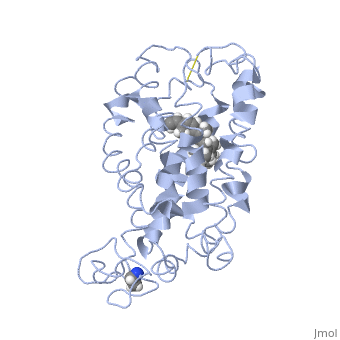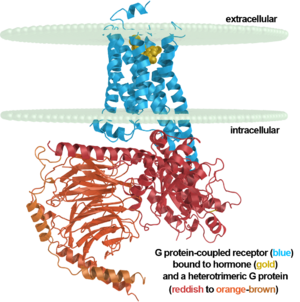Sandbox Reserved 1451
From Proteopedia
(Difference between revisions)
| Line 19: | Line 19: | ||
== Function == | == Function == | ||
| - | + | Rhodopsin performs two functions. One function is to bind retinal. Another function is to function as a G protein-coupled receptor. Rhodopsin is a protein that is essential for vision, especially in dim light. The photoreceptors in the retina that contain rhodopsin are rods. Rhodopsin is attached to 11-cis retinal which becomes excited by a photon of light. This excitation activates rhodopsin and leads to depolarizing of neurons. The depolarizing of neurons is how the image is transmitted to the brain. (https://ghr.nlm.nih.gov/gene/RHO#) | |
== Disease == | == Disease == | ||
| - | + | Mutations to rhodopsin can lead to stationary night blindness or retinitis pigmentosa. | |
| + | ''Autosomal Dominant Congenial Stationary Night Blindness'' | ||
| + | Stationary night blindness is an autosomal dominant disease that causes a loss of vision in dim light. The mutation to rhodopsin causes the protein to be constantly activated. Since the protein is continuously activated without any photon of light, the brain continues to receive stimulation from the photoreceptors. The brain begins to ignore the visual stimulation from the rods, therefore leading to night blindness. | ||
| + | ''Retinitis Pigmentosa'' | ||
| + | Retinitis pigmentosa is also an autosomal dominant disorder, but can also be recessive in rare circumstances. A mutation that affect rhodopsin that cause retinitis pigmentosa result in a misfolding or transportation of the protein. Another mutation to rhodopsin can affect the activation of the protein in response to light. These mutations can lead to apoptosis of rods in the retina. Without rods to perceive dim light, night blindness results. | ||
| + | (https://ghr.nlm.nih.gov/gene/RHO#) | ||
== Relevance == | == Relevance == | ||
[[Image:7tm labeled.png|right|300px]] | [[Image:7tm labeled.png|right|300px]] | ||
| - | + | Rhodopsin was the only GPCR that had a high-resolution crystal structure and was the basis for other GPCR structures. (https://www.ncbi.nlm.nih.gov/pubmed/24041646) | |
Revision as of 19:49, 11 April 2018
>
| This Sandbox is Reserved from Jan 22 through May 22, 2018 for use in the course Biochemistry II taught by Jason Telford at the Maryville University, St. Louis, Missouri, USA. This reservation includes Sandbox Reserved 1446 through Sandbox Reserved 1455. |
To get started:
More help: Help:Editing |
| |||||||||||


